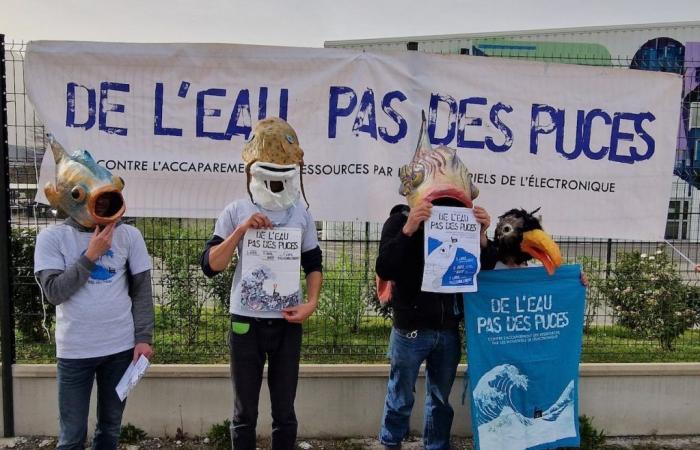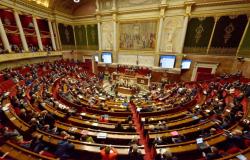850 to 2,000 demonstrators gathered in Grenoble in early April to denounce the monopoly of water resources by microelectronics manufacturers. The fact that the movement was born and is thriving in the capital of the Alps is no coincidence.
Although the term is overused, the city and its peninsula are the closest thing to a “French Silicon Valley”. Today known for its digital giants, the Californian valley takes its name from its historical role in semiconductors, of which silicon is the raw material. With its universities, research institutes and the semiconductor companies that have emerged from them, the capital of Isère can claim this title.
Presidential enthusiasm, local residents’ anger
« The collective was born from a form of “alignment of stars”, between the announcement of the extension of the STMicroelectronics site in Crolles and the heatwave of 2022, ” begins a spokesperson for StopMicro during a lively press conference. It is this collective that is at the origin of the demonstration which ended near the research and development center of STMicroelectronics (ST), on the Grenoble peninsula.
On Google Maps, the Grenoble peninsula is blurred due to the presence of many protected sites, whether it be the ST research and development center, CEA research institutes or others. Screenshot: Siècle Digital / Google Maps.
The Franco-Italian company and its expansion project in the region where it has been established for 30 years are the main target of StopMicro, which took its name from it. As luck would have it, another company in the sector, Soitec, unveiled the same project in a neighboring city. The company was added to the protest, but its management has since suspended its plans.
The reception was radically opposite on the side of the public authorities, very enthusiastic. These projects came at an opportune time for the government. Between the shortage of semiconductors in the early 2020s and the desire for sovereignty, Emmanuel Macron himself made the trip to announce the extension and present the “2030 electronic strategy”. The latter is integrated into the European Chips Act as well as the France Relance plan.
« By being among you today, I come to celebrate some good news. “, declared the President of the Republic, delighted, simply disturbed by a malaise in the audience due to the heat. In this speech, intended for the entire sector, he notably insisted on the contribution of semiconductors to the “climate transition”. A vision hardly shared by the StopMicro activists. At the heart of this disagreement, the monopolization of water resources. A priority summed up in a slogan: “Water, not chips”.
Semiconductors drink a lot of water…
As noted in the industrial component of the government’s Water Plan, unveiled at the end of March, ” Water is essential for the manufacture of electronic components ” Electronics is one of the 19 industrial sectors identified as needing to make water efficiency efforts.
ST reports to Digital Century that it is not one of the companies cited by the Water Plan as having to make efforts. This question nonetheless remains one, as the company itself acknowledges in its annual sustainable development report. We recognise our responsibility in addressing water challenges wherever we operate and continue to strengthen our efforts to address them. ».
The water consumption of a semiconductor factory (or FAB) varies according to several criteria: the modernity of the facilities, the company’s priorities, the accessibility of the resource, etc. But remains systematically significant. In Crolles, the ST factory must double its production of 300mm wafers. Wafers are disks of semiconductor materials on which integrated circuits are etched, 300mm designates the size of these disks, here, the largest possible.
« Our models show that the entire process of a wafer, in a 300mm FAB in large production volume, will consume roughly between 5 and 15 m3 of water per wafer. ” indicates to Digital Century Cédric Rolin, Program manager Sustainable Semiconductor Technologies and Systems (SSTS) at the Institute of Microelectronics and Components (IMEC), one of the world’s leading research institutes in the field of semiconductors.
The STMicroelectronics site, including the extension, is expected to consume 19,200 m3 of drinking water per day according to company documents. This corresponds to the range indicated by Cédric Rolin and to StopMicro’s estimates.
Why does a semiconductor factory need so much water? The resource has three main uses. The first of these is to clean wafers with artificially produced ultra-pure water. Producing chips means working at the nanometer level: the air in the clean rooms where the process is carried out is 10,000 times purer than that of an operating room. Everything that comes into contact with a wafer must be ultra-pure. Both the atmosphere in which it is transported, but also the water with which it comes into contact. ” explains Cédric Rolin. STMicroelectronics estimates that around 66% of its water usage is in this cleaning stage.
« The second largest consumer of water is the treatment of gaseous effluents. ” reports the IMEC researcher. ” Water in very fine particles that will, in a way, clean the “fumes” from the process. Some gaseous compounds condense and the particles will dissolve and dilute in the water ” Finally, the third and last major consumer of water is the plant’s cooling system. A FAB produces a lot of waste heat that needs to be eliminated. All together, this represents the last third of the water used by ST.
Schematic of water usage in a semiconductor fab. Image: STMicroelectronics
…Because in 20 years there won’t be any left?
This water consumption can be frowned upon by the local population, while they themselves have to put up with deprivations. This is what happened in 2022, when a major drought hit Isère. The prefecture ordered restrictions on individuals, such as a ban on filling their swimming pools or watering their gardens during the day. An exceptional deprivation, certainly, but one that raises doubts about the development of local consumption by industrialists.
Asked about this during a web conference on the ST project on April 10, Bruno Maneval, director of the environment and public services of Grenoble Alpes Métropole, brushed the problem aside. There is confusion about what is in tension and what is not. ” he judged. He assured that the difficulties of 2022 were localized, due to the organization of the network and not to generalized tensions over access to water.
Beyond the 2022 event, climate change implies a decline in resources in the coming decades. This must be taken into account.
To reduce water resource extraction, professionals have the option of recycling it. Ultra-pure water is contaminated during its use, but it can still be used to treat gas effluents or in a cooling tower. In its latest report, STMicroelectronics reports recycling, or reusing, 42% of its water. In addition, the company announced ” a pilot line to recycle part of the final aqueous discharges from the wastewater treatment plant » in Crolles.
The project was launched last year and should reach cruising speed this year, with up to 40 m3 recycled per hour. The new FABs, designed today, are extremely well thought out in terms of water recirculation. ” confirms Cédric Rolin. He warns, however, that conversely, once the factory is up and running, it is more complicated and costly to transform it.
Diagram of water treatment in Crolles by ST. Image: STMicroelectronics
Modernity of the facilities would be the key, unfortunately this is not the case because of the rebound effect. This effect, particularly verified in new technologies, means that efficiency gains, for example on water consumption, are cancelled out by the evolution of production. With more advanced technology, let’s say that this doubles the number of manufacturing steps and therefore doubles the impacts in general. “, describes the researcher. The ST case illustrates this.
The company has set itself the goal of consuming 20% less water per unit, compared to 2016. In 2023, this reduction will peak at 10%. It has also set itself the goal of recycling 50% of water in 2025, it is at 42%. These figures, from the group’s annual sustainable development report published in April 2024, are equal to, or even worse on consumption than those in the previous year’s report. Both cases are justified in the same way: ” This evolution is explained by the increased use of advanced manufacturing technologies, some of which have a larger manufacturing footprint. ».
The water that passes through the FAB of ST ends up returning to nature. 85% in liquid form, in the Isère river, the rest by evaporation. It passes before, and fortunately, through treatment stages. However, these may not be enough, ” Liquid effluents from a FAB can contain quite a few nutrients (nitrates and others) and therefore lead to an “algae explosion” which tends to suffocate watercourses. This is the concept of eutrophication of water ” reveals Cédric Rolin of IMEC. In Isère, a prefectural decree sets the ceiling for authorized discharges for STMicroelectronics. Too generous from StopMicro’s point of view.
Overall, in the Rhone watershed, water withdrawals are divided into 50% for irrigation, 25% for nuclear power plants and 5% for industrial activities including ST and Soitec. STMicroelectronics highlights the use of its chips in technologies designed to combat global warming. We believe that technology has a vital role to play in addressing the environmental, social and economic challenges facing our world. ” wrote Jean-Marc Chery, CEO of the company, in April.
For StopMicro, ST components are only used for ” electronic gadgets “, far from the considerations of sovereignty put forward by Emmanuel Macron. A word with assumed radicalism. The goal is to go beyond the question of water to bring about the debate on digital sobriety. In an ambient technosolutionist climate, this question is effectively little or not addressed at all. At a time of climate change, it might be worth at least starting to think about the subject and moving away from the caricatures of Amish or others used up to the top of power.






